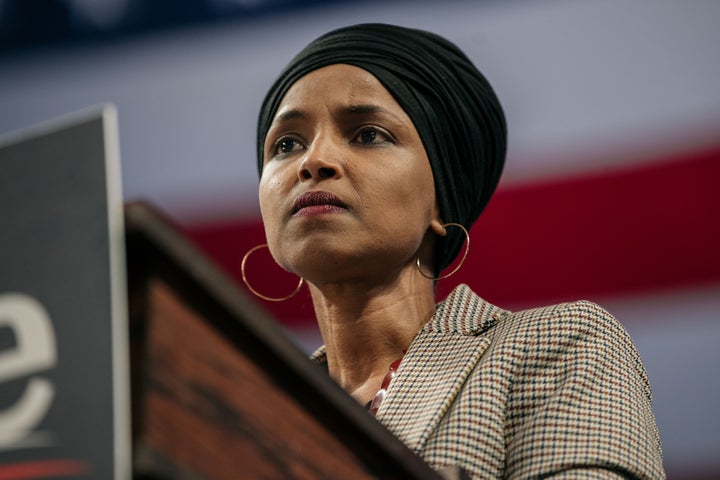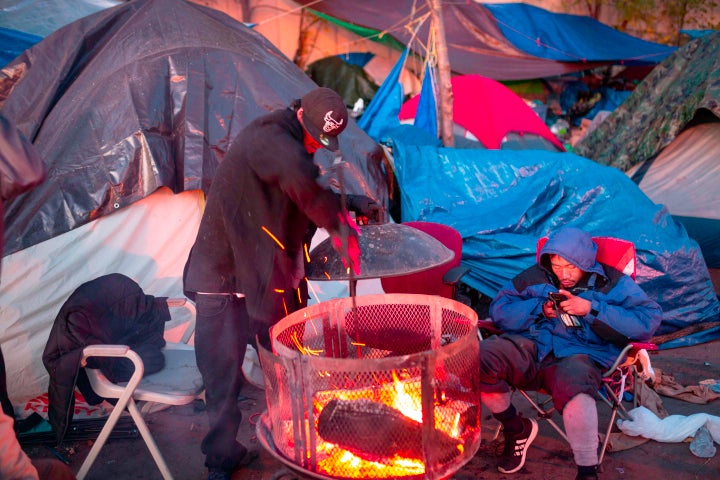Rep. Ilhan Omar (D-Minn.) plans to propose a bill Thursday that would invest $1.2 trillion over the next decade in 12 million new, affordable rental units.
The legislation, a draft of which HuffPost obtained, is arguably the most ambitious Green New Deal policy unveiled since the movement for a sweeping industrial plan to shrink climate-changing emissions and expand protections for the poor went mainstream a year ago.
It’s the marquee proposal in a wave of anticipated bills from a half dozen House Democrats seeking to make high-quality, affordable housing a central plank of the alternative political vision they hope to pitch ahead of the 2020 election.
More U.S. households rent than at any point since 1965, according to Pew Research Center data that found a sharp increase following the foreclosure crisis that started a decade ago. Over 11 million Americans spend more than half their paychecks on rent, per research from the affordability advocacy group Home1 that Curbed cited. A National Low Income Housing Coalition survey last year concluded that a renter working 40 hours a week and earning the federal minimum wage could afford a two-bedroom apartment in exactly zero counties nationwide.
It’s not just an urban crisis. Homelessness has increased in rural states such as South Dakota, according to figures from the National Alliance to End Homelessness.
“People make it sound like the people in the Midwest don’t have the same problems as people in New York and California, and this is one issue that unites us all,” Omar told HuffPost by phone Wednesday morning. “We are truly struggling.”

The bill comes a week after Rep. Alexandria Ocasio-Cortez (D-N.Y.) and Sen. Bernie Sanders (I-Vt.) released the so-called Green New Deal for Public Housing Act, a joint bill to spend, by one estimate, $172 billion over the next 10 years to upgrade the nation’s 1.2 million federally-owned rental units with clean power, efficient appliances and plumbing that won’t leach lead into water. Reps. Ayanna Pressley (D-Mass.), Rashida Tlaib (D-Mich.), Chuy Garcia (D-Ill.), Pramila Jayapal (D-Wash.) and Earl Blumenauer (D-Ore.) are expected to introduce more proposals in the months to come.
Omar’s bill, dubbed the Homes For All Act, goes further. Over a decadelong timeline, it outlines plans to build 9.5 million new units of public housing at the cost of about $800 billion. The legislation earmarks $200 billion for a federal Housing Trust Fund to build 2.5 million new affordable housing units available for low-income families. Another $200 billion would establish a Community Control and Anti-Displacement Fund at the Department of Housing and Urban Development to provide grants to local governments to combat the effects of gentrification.
The combined $1 trillion, for context, equals out to about what the 2009 stimulus bill to keep the U.S. economy from sliding into a depression spent when adjusted for inflation. But the four-comma spending figure puts legislative meat on the bones of multi-trillion-dollar climate platforms Democratic presidential candidates ranging from progressives such as Sanders and Sen. Elizabeth Warren (D-Mass.) to centrists Joe Biden and Pete Buttigieg have proposed.
“To arrive and see people sleeping on the side of the street is something that has stayed with me.”
- Rep. Ilhan Omar (D-Minn.)
Real estate accounts for about 12% of planet-heating emissions in the United States, federal data shows, but the actual figure could be as high as 39%, according to the U.S. Green Building Council, a nonprofit that promotes sustainable construction. Building new public housing “designed built and operated to the highest possible environmental standards” could seriously make a dent in those emissions, Omar said. It could also send market signals that compel private industry to follow suit. New York’s public housing agency’s request in the 1990s for energy-efficient refrigerators, for example, spurred a major shift toward energy saving in the appliance market, according to a study by the American Council for an Energy-Efficient Economy.
As millions of Americans and refugees from overseas are displaced by extreme weather, sea-level rise and conflict over increasingly scarce freshwater, Omar said, clean, desirable public housing is key to resettling them.
“When I came to the United States, [homelessness] was the first thing … that was jarring to me and that I never really expected,” said Omar, herself a Somali refugee who first arrived to New York from Kenya in 1995 and then eventually settled in Minneapolis. “To arrive and see people sleeping on the side of the street is something that has stayed with me.”
It would be shocking if the Homes For All Act became law in the next year. President Donald Trump, a Republican real estate developer with a history of housing discrimination, rejects the reality that emissions from buildings and vehicles are destabilizing the global climate. He would almost certainly veto the bill even if it passed the GOP-controlled Senate.
The legislation is also likely to face strong opposition from centrist Democrats who, in some cases, voted for President Bill Clinton’s welfare reform in the 1990s, when the party embraced fiscal conservatism to court a base of white, suburban voters. The effort put new restrictions on public services for the poor and all but ended investments in the federal housing projects that boomed half a century earlier under President Franklin Roosevelt, a fellow Democrat. That included passing the Faircloth Amendment, which barred the federal government from building new public housing after 1999 and severely limited the renovations the Department of Housing and Urban Development can fund.
Since then, federal authorities have demolished about 250,000 units and left much of the existing public housing stock in squalor.
The bill would repeal the Faircloth Amendment and require Congress to fully fund public housing operations in the federal budget the same way it does Medicare and Social Security.
That could, if enacted, reverse a decline in public housing and federal housing vouchers from 45 units per 1,000 American households in 1993 to 35 units per 1,000 American households today, said Yonah Freemark, a housing policy expert and doctoral student in city planning at the Massachusetts Institute of Technology.

“That decline is indicative of a failure of the federal government to keep up with population growth and a failure to maintain what’s there,” he said. He dismissed critics who say public housing agencies are hotbeds of corruption. “Sure, there are examples of poor performance in public agencies, but there are also examples of slumlords.”
The bill has no co-sponsors yet. But it’s likely to gain support from progressive allies who back the Green New Deal movement to restore the last century’s federal safety net and update it to address the climate crisis.
Omar said she plans to appeal to her more moderate colleagues to “rewrite their legacies” and correct for the injustices that came from Democrats’ rightward shift nearly three decades ago. She compared the dynamic to criminal justice reform, invoking the Democrats and Republicans who supported draconian laws in the 1990s that punished millions of mostly minority men for nonviolent offenses and who are now considering ways to reverse the trend.
“This is their opportunity to make amends,” she said. “Sometimes we don’t have the foresight of the harm some of the policies we propose could have. They are now presented with some of those harms that they’ve caused and they get to fix it.”
That’s a political message that could buoy Democrats in critical swing states Trump won in 2016. Michigan, for example, is slated to face a shortfall of more than 150,000 affordable units by 2045, the state housing agency forecast in April. That forecast comes two years after the Home Builders Association of Michigan issued a “wake-up call” over the looming housing crisis.
“Even in rural communities, this is a serious challenge,” said Abdul El-Sayed, the progressive who came in second in last year’s Democratic gubernatorial primary in Michigan. “People are realizing the gig they’re working in an economy where there’s an underemployment epidemic don’t allow them to put a roof over their heads.”
